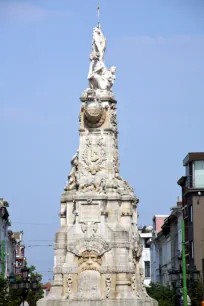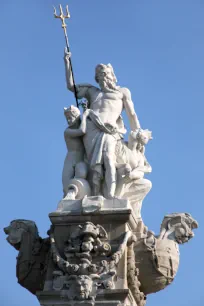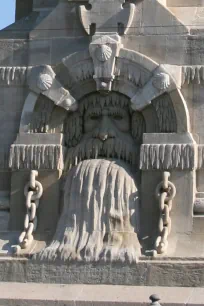In 1873 a large monument was inaugurated to commemorate the settlement with the Netherlands that allowed for free passage of ships to Antwerp, vital for the city’s maritime commerce.



Dutch control over the Scheldt
The fortune of the city of Antwerp has always been closely tied with that of its port. In 1585, with the Fall of Antwerp and following occupation by the Spanish, the Dutch cut off access to the city by blocking traffic on the Scheldt river. Even after the Peace of Münster in 1648, which ended the 80 Years’ War between Spain and the Netherlands, the Dutch levied a heavy toll on ships sailing to Antwerp, curtailing its growth.
Finally, a settlement in 1863 between Belgium and the Netherlands put an end to this practice. To commemorate this important event, the city council decided to build a large monument.
The Monument
The stone monument, which was aptly named ‘Schelde Vrij’ (Scheldt Free), was installed in 1873 at the new Zuid neighborhood. It was designed by Jan Jacob Winders – best known for his Royal Museum of Art – who created a bombastic monument, twenty meters tall (66 ft) and decorated with plenty of statuary and reliefs.
Standing triumphantly at the top is Neptune, god of the sea, holding a trident in his right hand. He is flanked by Mercury, god of trade, and a kneeling woman representing the city of Antwerp. Behind them is a small boy taking notes. Below the monument is adorned with ships’ prows, medallions, garlands, lions and at the pedestals are reliefs of water gods spouting Scheldt water. Another figure above the water gods is shown writing the words ‘Schelde Vrij’ on the monument.
The statues were designed by a group of sculptors. Jaak de Braekeleer created Neptune and Mercury, ‘Antwerp’ was created by Frans Joris and the lions were created by Louis Dupuis. The monument is hemmed in by an iron fence, with beautiful cast-iron streetlamps on each corner.
Marnix Square
The monument is located at the center of the Marnixplaats (Marnix Square), a circular square from which eight streets emanate. The name of the square refers to Marnix van St. Aldegonde, mayor of Antwerp during the fall of the city in 1585. The nearby Lambermont Square is named after the man who is credited for the freeing of the Scheldt, Auguste Lambermont.
- Next: Zoo
- More Sights & Attractions in Antwerp

